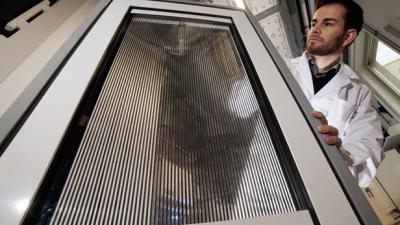Most of the smart window systems we've seen in the past are electrochromic, meaning they change tint or opacity in response to electrical signals passing through wires embedded in the glass. That lets users cloud the window over if they want both privacy and natural light, or darken the glass to keep the house cool.
This new system has similar applications but takes a completely different approach. To make a fluidic window, magnetic iron nanoparticles are suspended in a liquid, which is contained inside vertical channels in the glass itself. These particles cloud up the window, blocking light to different degrees and soaking up heat as needed. When you want to make it transparent, switching the LaWin on triggers magnets to pull these particles out of the liquid.
"Our project's key feature is the use of liquids in windows and façades, for example, as heat carriers or to enable additional functions," says Lothar Wondraczek, coordinator of the project. "To this end we develop new glass materials, into which large-area channel structures are integrated. These are used for circulating functional fluids. Depending on the number of the iron particles in the liquid, the liquid itself takes on different shades of grey, or it will even turn completely black. Then, it becomes possible to automatically adjust the incidence of light, or to harvest solar heat which can then be put to further use within the building."
In terms of heat gain by area, the researchers say the system is as about as efficient as solar thermal facilities. The team also says that no electrical connection is needed at the windows because toggling the particle capture system "happens in a separate tank."
The LaWin system might be more fiddly to produce, since the specialty channels need to be built right into the glass, but according to the developers these windows should continue to function for as long as the building is in use. While the current prototypes were manufactured in batches measuring 200 sq m (2,150 sq ft), the researchers say the technology should be scalable to standard sizes of window frames, including double- and triple-glazing frames.
The end goal is to cut back on energy costs, particularly in terms of heating and cooling of buildings which can make up a huge percentage of energy consumption. The design has already been funded to the tune of several million euros, and commercial applications are apparently planned for later in 2018.
A research paper describing the prototype was published in the journal Advanced Sustainable Systems.
Source: New Atlas - Friedrich-Schiller University Jena || January 17, 2018 |||





